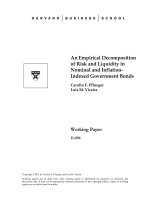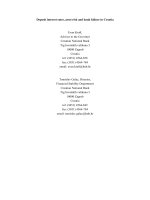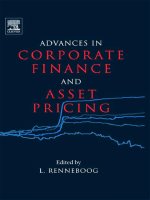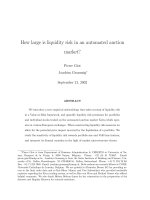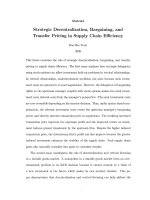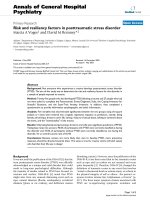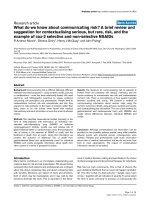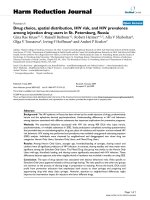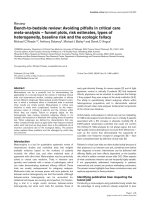liquidity risk and asset pricing
Bạn đang xem bản rút gọn của tài liệu. Xem và tải ngay bản đầy đủ của tài liệu tại đây (1.49 MB, 210 trang )
LIQUIDITY RISK AND ASSET PRICING
DISSERTAT ION
Presented in Partia l Fulfillment of the Requirements for
the Degree Doctor of Philosophy in the
Graduate School of The Ohio State University
By
Kuan-Hui Lee, M.A.
* * * * *
The Ohio State University
2006
Dissertati on Commit tee:
G. Andrew Karolyi, Adviser
Kewei Hou
Ren´e M. Stulz
Ingrid M. Werner
Approved by
Adviser
Graduate Program in
Business Administration
ABSTRACT
In this dissertation, I investigate the effect of liquidity risk on asset pricing. In
the first essay, I test the liquidity-adjusted capital asset pricing model (LCAPM) of
Acharya and Pedersen (2005) for 1962-2004 in the US market using various liquidity
proxies. In a time-series test with a one-factor (market model), three-factor (excess
market return, SMB, and HML) a nd four-factor model (excess market return, SMB,
HML and MOM) as well as in a Fama-MacBeth regression, I find that test results
vary according to the liquidity measures used, to the test methodology, to the test
assets, and to the weighting scheme. Tests based on the liquidity measure of Ami-
hud (2002), Pastor and Stambaugh (2003) and zero-return proportion show some
evidence that liquidity risks are priced, but in most cases, I could not find evidence
that supports the LCAPM. The second essay specifies and tests an equilibrium as-
set pricing model with liquidity risk a t the global level. The analysis encompasses
25,000 individual stocks from 48 developed and emerging countries around the world
from 1988 to 2004. Though I cannot find evidence that the LCAPM holds in interna-
tional financial markets, cross-sectional as well as time-series tests show that liquidity
risks arising from the covariances of individual stocks’ return and liquidity with local
and global market factors are priced. Furthermore, I show that the US market is
an important driving force of world-market liquidity risk. I interpret our evidence as
consistent with an intertemporal capital asset pricing model (Merton (1973)) in which
ii
stochastic shocks to global liquidity serve as a priced state variable. The third essay
investigates how and why liquidity is transmitted across stocks. In a vector autore-
gressive framework, I uncover a dynamic interaction of liquidity across size portfolios
in that past changes of liquidity of large stocks are positively correlated with current
changes of liquidity of small stocks. Furthermore, liquidity spillovers are not restricted
among fundamentally-related stocks and are independent of the dynamics in return
and volatility spillovers. This finding implies that the process of liquidity generation
is independent of infor matio n flows and that portfolio diversification strategies should
consider different patterns in return, volatility and liquidity spillovers.
iii
to my parents
iv
ACKNOW LEDGMENTS
I don’t know how to thank enough for having such an exceptional doctoral com-
mittee. I wish to thank Kewei Hou, G. Andrew Karolyi, Ren´e Stulz, and Ingrid M.
Werner for their continual support and encouragement.
I am most grateful to my a dvisor, G. Andrew Karolyi, for his tremendous support,
guidance and encouragement. Throughout my doctoral work he encouraged me to
develop my analytical thinking and research skills. His assistance guided me not only
to a better researcher, but also to a better instructor.
I wish to express my deep appreciation to Ren´e Stulz whose consultation, insightful
comments and encouragement were continual stimulation to my research.
I am deeply indebted to Ingrid M. Werner whose help, guidance, patience and
encouragement tremendously helped me in all my doctoral training process.
I would like to thank Kewei Hou for his insightful comments, efforts and guidance.
I also thank Karl Diether, Bing Han and Jean Helwege for their encouragement
and friendship and thank Bong-Chan Kho for being an excellent role model even from
my school life in Seoul many years ago. I thank my brother Tae-Hwy Lee, who is a
time-series econometrician, for guiding me in pursuing academic career.
I want to share my happiness and thankfulness with my friend, Jungwu Rhie, who
passed away by tragic accident last year and may rest in peace in heaven.
v
VITA
November 9, 1970 . . . . . . . . . . . . . . . . . . . . . . . . . . Born - Taejon, Korea
1989-1996 . . . . . . . . . . . . . . . . . . . . . . . . . . . . . . . . . . B.B.A. Business Administration,
Seoul National University
1997-1999 . . . . . . . . . . . . . . . . . . . . . . . . . . . . . . . . . . MBA, International Finance,
Seoul National University
1999-2001 . . . . . . . . . . . . . . . . . . . . . . . . . . . . . . . . . . M.S. Statistics,
University of North Carolina, Chapel
Hill
2001-present . . . . . . . . . . . . . . . . . . . . . . . . . . . . . . . .Graduate Teaching and Research Asso-
ciate,
The Ohio State University.
FIELDS OF STUDY
Major F ield: Business Administration
Studies in:
International Finance
Empirical Asset Pricing
Market Microstructure
vi
TABLE OF CONTENTS
Page
Abstract . . . . . . . . . . . . . . . . . . . . . . . . . . . . . . . . . . . . . . . ii
Dedication . . . . . . . . . . . . . . . . . . . . . . . . . . . . . . . . . . . . . . iv
Acknowledgments . . . . . . . . . . . . . . . . . . . . . . . . . . . . . . . . . . v
Vita . . . . . . . . . . . . . . . . . . . . . . . . . . . . . . . . . . . . . . . . . vi
List of Tables . . . . . . . . . . . . . . . . . . . . . . . . . . . . . . . . . . . . x
List of Figures . . . . . . . . . . . . . . . . . . . . . . . . . . . . . . . . . . . xii
Chapters:
1. Introduction . . . . . . . . . . . . . . . . . . . . . . . . . . . . . . . . . . 1
2. Testing the Liquidity-Adjusted Capital Asset Pricing Model using Differ-
ent Measures of Liquidity . . . . . . . . . . . . . . . . . . . . . . . . . . 4
2.1 Introduction . . . . . . . . . . . . . . . . . . . . . . . . . . . . . . 4
2.2 Liquidity-Adjusted Capital Asset Pricing Model . . . . . . . . . . . 8
2.3 Data and Iliquidity Measures . . . . . . . . . . . . . . . . . . . . . 11
2.4 Methodology . . . . . . . . . . . . . . . . . . . . . . . . . . . . . . 16
2.4.1 Fama-MacBeth Regression . . . . . . . . . . . . . . . . . . . 17
2.4.2 Time-Series Tests . . . . . . . . . . . . . . . . . . . . . . . . 19
2.5 Empirical Results . . . . . . . . . . . . . . . . . . . . . . . . . . . . 21
2.5.1 Time-Series Tests . . . . . . . . . . . . . . . . . . . . . . . . 21
2.5.2 Fama-MacBeth Regression . . . . . . . . . . . . . . . . . . . 23
2.6 Conclusion . . . . . . . . . . . . . . . . . . . . . . . . . . . . . . . 28
vii
3. The World Price of Liquidity Risk . . . . . . . . . . . . . . . . . . . . . . 30
3.1 Introduction . . . . . . . . . . . . . . . . . . . . . . . . . . . . . . 30
3.2 Related literature . . . . . . . . . . . . . . . . . . . . . . . . . . . . 33
3.3 Liquidity-adjusted capital asset pricing model . . . . . . . . . . . . 36
3.4 Data and liquidity measure . . . . . . . . . . . . . . . . . . . . . . 39
3.4.1 Sample screening . . . . . . . . . . . . . . . . . . . . . . . . 39
3.4.2 Summary statistics . . . . . . . . . . . . . . . . . . . . . . . 43
3.4.3 Is zero-return proportion a good proxy for illiquidity? . . . . 45
3.5 Methodology . . . . . . . . . . . . . . . . . . . . . . . . . . . . . . 48
3.5.1 Innovations of return and illiquidity . . . . . . . . . . . . . 48
3.5.2 Estimating predicted betas . . . . . . . . . . . . . . . . . . 49
3.6 Empirical results . . . . . . . . . . . . . . . . . . . . . . . . . . . . 53
3.6.1 Local and global market betas . . . . . . . . . . . . . . . . 53
3.6.2 Fama-MacBeth test results for local liquidity risks . . . . . 55
3.6.3 Fama-MacBeth test results for global liquidity risks . . . . . 57
3.6.4 Fama-MacBeth test results for local and world market liq-
uidity risks . . . . . . . . . . . . . . . . . . . . . . . . . . . 59
3.6.5 Do US markets drive world market liquidity risks? . . . . . 63
3.6.6 Time series tests . . . . . . . . . . . . . . . . . . . . . . . . 66
3.6.7 Subperiod analysis . . . . . . . . . . . . . . . . . . . . . . . 70
3.7 Robustness tests . . . . . . . . . . . . . . . . . . . . . . . . . . . . 72
3.7.1 Different innovation . . . . . . . . . . . . . . . . . . . . . . 73
3.7.2 Two-way sorts . . . . . . . . . . . . . . . . . . . . . . . . . 73
3.8 Conclusion . . . . . . . . . . . . . . . . . . . . . . . . . . . . . . . 76
4. Liquidity Spillovers . . . . . . . . . . . . . . . . . . . . . . . . . . . . . . 78
4.1 Introduction . . . . . . . . . . . . . . . . . . . . . . . . . . . . . . 78
4.2 Literature Review . . . . . . . . . . . . . . . . . . . . . . . . . . . 83
4.2.1 Theories . . . . . . . . . . . . . . . . . . . . . . . . . . . . . 83
4.2.2 Empirical Studies . . . . . . . . . . . . . . . . . . . . . . . . 85
4.3 Hypotheses . . . . . . . . . . . . . . . . . . . . . . . . . . . . . . . 88
4.4 Data and Liquidity Measure . . . . . . . . . . . . . . . . . . . . . . 90
4.5 Liquidity Spillovers . . . . . . . . . . . . . . . . . . . . . . . . . . . 92
4.5.1 Vector Autoregression . . . . . . . . . . . . . . . . . . . . . 95
4.5.2 VAR Estimation Results . . . . . . . . . . . . . . . . . . . . 97
4.6 Are Liquidity Spillovers Related to Correlated Fundamentals or In-
formation Flow? . . . . . . . . . . . . . . . . . . . . . . . . . . . . 99
4.6.1 Intra-Industry Liquidity Spillovers . . . . . . . . . . . . . . 99
4.6.2 Intra- vs Inter-Industry Liquidity Spillovers . . . . . . . . . 10 2
viii
4.6.3 Does Information Flow Contribute in Liquidity Spillovers? . 105
4.6.4 Does Style Investing Contribute to Liquidity Spillovers? . . 106
4.7 Robustness Checks . . . . . . . . . . . . . . . . . . . . . . . . . . . 115
4.7.1 Alternative Lags . . . . . . . . . . . . . . . . . . . . . . . . 116
4.7.2 Value-Weighted Average . . . . . . . . . . . . . . . . . . . . 116
4.8 Discussion . . . . . . . . . . . . . . . . . . . . . . . . . . . . . . . . 118
4.9 Conclusion . . . . . . . . . . . . . . . . . . . . . . . . . . . . . . . 119
5. Conclusion . . . . . . . . . . . . . . . . . . . . . . . . . . . . . . . . . . . 122
Bibliography . . . . . . . . . . . . . . . . . . . . . . . . . . . . . . . . . . . . 124
Appendices:
A. Tables . . . . . . . . . . . . . . . . . . . . . . . . . . . . . . . . . . . . . 131
B. Figures . . . . . . . . . . . . . . . . . . . . . . . . . . . . . . . . . . . . . 174
ix
LIST OF TABLES
Table Page
A.1 Summary Statistics . . . . . . . . . . . . . . . . . . . . . . . . . . . . 132
A.2 Betas by Size Group . . . . . . . . . . . . . . . . . . . . . . . . . . . 133
A.3 Intercepts from the Market Model Regression . . . . . . . . . . . . . 134
A.4 Intercepts from the Three Factor Model Regression . . . . . . . . . . 135
A.5 Intercepts from the Four Factor Model Regression . . . . . . . . . . . 136
A.6 Fama- French Regression of Size Portfolios with Value-Weighted Market
Illiquidity . . . . . . . . . . . . . . . . . . . . . . . . . . . . . . . . . 137
A.7 Fama- French Regression of Size Portfolios with Equal-Weighted Mar-
ket Illiquidity . . . . . . . . . . . . . . . . . . . . . . . . . . . . . . . 139
A.8 Fama- French Regression of Illiquidity Portfolios with Value-Weighted
Market Illiquidity . . . . . . . . . . . . . . . . . . . . . . . . . . . . . 141
A.9 Fama- French Regression of Illiquidity Portfolios with Equal-Weighted
Market Illiquidity . . . . . . . . . . . . . . . . . . . . . . . . . . . . . 143
A.10 Summary Statistics (Liquidity and Return in World Financial Markets) 145
A.11 Correlation of Liquidity Measures by Size in US Market . . . . . . . . 147
A.12 Coefficients from the estimation of predicted betas . . . . . . . . . . . 148
A.13 Mean of Portfolio formed based on Predicted Betas . . . . . . . . . . 149
x
A.14 Fa ma-French Regression by Predicted Betas (Local Market) . . . . . 150
A.15 Fa ma-French Regression by Predicted Betas (World Market) . . . . . 151
A.16 Fa ma-French Regression by Predicted Betas (Local and World Market) 152
A.17 Fa ma-French Regression by Predicted Betas with resp ect to US market
and Non-US World Markets . . . . . . . . . . . . . . . . . . . . . . . 153
A.18 Time-Series Tests . . . . . . . . . . . . . . . . . . . . . . . . . . . . . 154
A.19 Fa ma-French Regression by Global Predicted Betas (Subperiod) . . . 156
A.20 Fa ma-MacBeth regression with 2 5 portfolios for US market . . . . . . 158
A.21 Fa ma-MacBeth regression with post-ranking betas (2-way sorts) . . . 159
A.22 Descriptive Statistics . . . . . . . . . . . . . . . . . . . . . . . . . . . 161
A.23 VAR Estimation Results . . . . . . . . . . . . . . . . . . . . . . . . . 162
A.24 Zero-Block Exclusion Tests . . . . . . . . . . . . . . . . . . . . . . . . 163
A.25 Summary Statistics for Industry-Size Portfolios . . . . . . . . . . . . 165
A.26 Within-Industry Liquidity Spillovers . . . . . . . . . . . . . . . . . . 16 8
A.27 Intra- vs Inter-Industry Liquidity and Volatility Spillovers . . . . . . 170
A.28 Spillovers in Size-B/M Style . . . . . . . . . . . . . . . . . . . . . . . 172
A.29 Style vs Industry . . . . . . . . . . . . . . . . . . . . . . . . . . . . . 173
xi
LIST OF FIGURES
Figure Page
B.1 Market Illiquidity and Return . . . . . . . . . . . . . . . . . . . . . . 175
B.2 Intercepts from Market Model Regression (Liquidity Net Beta) . . . . 178
B.3 Intercepts from Market Model Regression (Net Beta) . . . . . . . . . 181
B.4 Intercepts from Three Factor Model Regression (Liquidity Net Beta) 184
B.5 Intercepts from Three Factor Model Regression (Net Beta) . . . . . . 187
B.6 Intercept from four factor model regression (liquidity net beta) . . . . 190
B.7 Intercept from four factor model regression (net beta) . . . . . . . . . 193
B.8 Correlation of Liquidity Measures in US Market . . . . . . . . . . . . 196
B.9 Intercepts from Market Model Regression . . . . . . . . . . . . . . . . 197
B.10 Daily Quoted Spread . . . . . . . . . . . . . . . . . . . . . . . . . . . 198
xii
CHAPTER 1
INTRODUCTION
In classical asset pricing models, perfect financial markets without frictions, es-
pecially no trading costs, are assumed and thus the diverse features of liquidity are
ignored.
1
However, considering liquidity in investment is important since liquidity
affects portfolio investment performance (Holthausen, Leftwich, and Mayers (1991),
Keim (2004), Lesmond, Schill, and Zhou (2004), Korajczyk and Sadka (2004)) and
it has a significant implication for portfolio diversification strategies (Domowitz and
Wang (2002), Harford and Kaul (2005)). In addition, it has been shown that liquidity
affects the cross-sectional differences of asset returns as a characteristic (Amihud and
Mendelson (1986), Brennan and Subrahmanyam (1996), Amihud (2002)) or as a risk
factor (Pastor and Stambaugh (2003), Sadka (2004), Acharya and Pedersen (2005)).
This dissertation consists of three essays devoted to investigating the effect of
liquidity risk on asset pricing. In the first essay, I test the liquidity-adjusted capi-
tal asset pricing model (LCAPM) of Acharya and Pedersen (2005) for 1962-2004 in
1
Liquidity is a co nce pt used to ca pture the various trading costs and it has many, and potentially
overlapping dimensions arising from adverse selec tion (Bagehot (1971), Copeland and Galai (1983),
Kyle (1985), Glosten and Milgrom (1985)), and needs for immediate trading (Demsetz (1968), Tinic
(1972), Stoll (1978), Ho and Stoll (1980), Cohen, Maier, Schwartz, and Whitcomb (1981), Ho and
Stoll (1981), Ho and Stoll (1983), Grossman and Miller (1988)). Broadly, it is use d to describe the
ease of trading a large amount of shares in a given amount of time without a significant impact on
prices.
1
the US market using various liquidity proxies. The LCAPM is attractive in that it
covers various channels through which liquidity may affect asset prices in one model
while incorporating tra ditional market risk as well. Liquidity risk that arises from
the covariance of individual stock return with market liquidity, which is investigated
by Pastor a nd Stambaugh (2003), is present in the LCAPM a s one source of r isk
through which liquidity affects asset prices. Commonality in liquidity, which de-
notes the comovement of individual stock liquidity with market liquidity (Chordia,
Roll, a nd Subrahmanyam (2000 ), Hasbrouck and Seppi (2001), Huberman and Halka
(2001)), is also captured in the LCAPM. In addition, the LCAPM proposed a new
source of liquidity risk, which arises from t he covariance of individual stock liquid-
ity with market returns. While the LCAPM covers liquidity as a risk factor, it also
encompasses liquidity level in the model. Hence, the test of the LCAPM gives us
an opportunity to investigate the effect of liquidity on asset prices through various
channels. In a time-series test with a one-factor (market model), three-factor (excess
market return, SMB, and HML) a nd four-factor model (excess market return, SMB,
HML and MOM) as well as in a Fa ma-MacBeth regression, I find that test results vary
according to the liquidity measures used, to the test methodology, to the test assets,
and to the weighting scheme. Tests based on the liquidity measure of Amihud (2002),
Pastor and Stambaugh (2003) and zero-return proportion show some evidence that
liquidity risks are priced, but in most cases, I could not find evidence that supports
the LCAPM.
The second essay extends the study of liquidity risk and a sset pricing to interna-
tional financial markets by t esting the LCAPM at the global level. The analysis en-
compasses 25,000 individual sto cks from 48 developed and emerging countries around
2
the world f r om 1988 to 2004. Though I cannot find evidence that the LCAPM holds
in international financial markets, cross-sectional as well as time-series tests show
that liquidity risks arising from the covariances of individual stocks’ returns and liq-
uidity with local and global market factors are priced. Furthermore, I show that the
US market is an important driving force of world-market liquidity risk. I interpret
our evidence as consistent with an intertemporal capital asset pricing model (Merton
(1973)) in which stochastic shocks to global liquidity serve as a priced state variable.
The third essay investigates how and why liquidity is transmitted across stocks.
In a vector autoregressive fr amework, I uncover a dynamic interaction o f liquidity
across size portfolios in that past changes of liquidity o f large stocks are positively
correlated with current changes of liquidity of small stocks. Furthermore, liquidity
spillovers are not restricted among fundamentally-related stocks and are independent
of the dynamics in return and volatility spillovers. This finding implies that the
process of liquidity generation is independent of information flows and that portfolio
diversification strategies should consider different patterns in return, volatility and
liquidity spillovers.
3
CHAPTER 2
TESTING THE LIQUIDITY-ADJUSTED CAPITAL
ASSET PRICING MODEL USING DIFFERENT
MEASURES OF LIQUIDITY
2.1 Introduction
Tr ading activity incurs trading costs, which are explicit (e.g. brokerage commis-
sion) and implicit (e.g. price impact, price of immediacy). While prior studies have
focused on the impact of liquidity level on asset prices (Amihud and Mendelson (1986),
Brennan and Subrahmanyam (1996), Amihud (2002)), recently have researchers be-
gun to investigate liquidity as an undiversifiable source of risk (Pastor and Stam-
baugh (2003), Acharya and Pedersen ( 2005)). Acharya and Pedersen (2005) propose
a theoretical model, the liquidity-adjusted capital asset pricing model (the LCAPM,
henceforth), that encompasses liquidity as a stock characteristic as well as a source of
various undiversifiable risks. However, they tested the model using a specific proxy
and a particular test methodology. In this paper, I test the LCAPM for 1962-2004
in the US market and investigate the robustness of their conclusion using var io us
liquidity proxies and test methodologies.
While explicit trading costs are easy to measure, this is not so for implicit trading
costs. For example, it is hard to measure price impact cost, which is defined as the
4
difference in price when the trading occurs and that when the trading do es not occur,
since it requires a benchmark price which could have been determined in the absence
of trading. Liquidity (or illiquidity) is a concept that captures these trading costs.
Previous studies in the asset pricing field have devoted a lot of effort to suggest valid
measures of such trading costs.
Liquidity proxies based on high frequency data have received a lot of attention as
desirable measures (Amihud and Mendelson (1986), Huang and Stoll (1 997), Chordia,
Sarkar, and Subrahmanyam (200 5), a mong others). However, high f requency data is
available only for a relatively short period of time as data from the Institute fo r the
Study and Securities Markets (ISSM) starts in 1983.
Hence, many researchers have suggested proxies of liquidity based on daily return
and trading volume since they give longer time-series of liquidity. R oll (1984), for
example, suggested a proxy of spread based on serial correlation of daily returns.
Turnover, which is defined as daily share trading volume divided by the number of
total shares outstanding, has also been a popular measure of liquidity. The theoretical
motivation for using turnover as a liquidity proxy goes back to Demsetz (1968) and
Glosten and Milgrom (1985). Demsetz (1968) shows that the price of immediacy
would be smaller for stocks with high trading frequency since frequent t rading reduces
the cost of inventory controlling. On the other hand, Glosten and Milgrom (1985)
shows that stocks with high trading volume would have lower level of information
asymmetry to the extent that information is revealed by prices. Amihud (2002)
proposed a simple and intuitive liquidity measure, which is defined as the absolute
daily return divided by daily trading volume. Pastor and Stambaugh (2003) prop osed
a liquidity measure based on return reversal. More recently, Lesmond, Ogden, and
5
Tr zcinka (1999) prop osed an liquidity measure based solely on daily returns relying
on the idea that informed traders would not trade on a day when the stock is highly
illiquid.
2
While these measures have many benefits in that they provide relatively long time-
series of liquidity for researchers and more importantly, in that they are simple, there
have been arguments questioning the reliability of these liquidity measures (Hasbrouck
(2005), Goyenko, Holden, Lundblad, and Trzcinka (2005)). Given the limitations of
various liquidity measures, I construct each of these measures using daily returns and
trading volume data from CRSP for 1962 to 2004. Acharya and Pedersen (2005)
used the liquidity proxy of Amihud (2002) and found evidence validating the model
in the US market for 1962-1999. This paper examines whether this empirical result
is unique to the specific measure used. For comprehensive tests of the model, we
employ two different test methodologies of Fama-MacBeth cross-sectional regression
and time-series test.
The LCAPM is attractive in that it covers various channels through which liquidity
may affect asset prices in one model while incorporating traditional market risk as
well. Liquidity risk that ar ises from the covariance of individual stock return with
market liquidity, which is investigated by Pastor and Stambaugh (2003), is present
in the LCAPM as one source of risk through which liquidity affects asset prices.
Commonality in liquidity, which denotes the comovement of individual stock liquidity
with market liquidity (Chordia, Roll, a nd Subrahmanyam (2000), Hasbrouck and
Seppi (2001), Huberman a nd Halka (2001)), is also captured in the LCAPM. In
addition, the LCAPM proposed a new source of liquidity risk, which arises from the
2
All of these measures will be introduced in detail in section 2.3.
6
covariance of individual stock liquidity with market returns. While the LCAPM covers
liquidity as a risk factor, it also encompasses liquidity level in the model. Hence, the
test of the LCAPM gives us an opport unity to investigate the effect of liquidity on
asset prices through various channels.
In time-series tests with one-factor (market model), three-factor (excess market
return, SMB, and HML) and four-factor models (excess market return, SMB, HML
and MOM) as well as in Fama-MacBeth cross-sectional regression tests, we find that
the results are sensitive to the liquidity measures, to the test assets used, to the
weighting scheme and to the test methodologies. Tests based on liquidity measure of
Amihud (2002), Pastor and Stambaugh (2003) and zero-return proportion suggested
that liquidity risks are priced, but in most cases, we could not find evidence supporting
the LCAPM.
Given the findings in this paper, an important question may arise. Why some
of the measures show supporting evidence of the LCAPM while others do not? Is
it because of the different level of goodness of each measure? Or, is it because each
measure proxies different aspect of liquidity? I think both can be at least the part
of the answer. First, proxies of trading costs used in this paper are, as manifested in
the previous studies (Goyenko, Holden, Lundblad, and Trzcinka (2005), Hasbrouck
(2005), Lesmond (2005)), noisy measures. In a recent paper of Korajczyk and Sadka
(2006), common factors across eight different liquidity measures
3
are shown to be
strongly priced. This result may come from reducing noise of each liquidity measure
by principal component analysis as well as from capturing common systematic as-
pects of liquidity that each liquidity measure jointly proxies for. Second, and more
3
Those measures are Amihud (2002), turnover, quoted spread, effective spread, and four mea sures
from Sadka (2004).
7
importantly, I did not consider the impact of different holding periods on liquidity
in the empirical tests (Amihud and Mendelson (1986), Constantinides (1986), Atkins
and Dyl (1 997), Chalmers and Kadlec (1998) ) . By using monthly return and liquidity,
we implicitly assume that the investors’ holding period is one month, which may be
a strong assumption.
This paper is organized as follows. In section 2.2, Acharya and Pedersen (2005)’s
LCAPM is introduced. Data and liquidity proxies are illustrated in section 2.3 and
the test methodology is shown in section 2.4. Empirical results are summarized in
section 2.5 separately by different methodologies. I conclude in section 2.6.
2.2 Liquidity-Adjusted Capital Asset Pricing Model
It has been empirically shown that liquidity is a priced factor both as a character-
istic and as a systematic risk factor. However, a theoretical asset pricing model that
includes both of these aspects of liquidity was proposed only recently. The liquidity-
adjusted capital asset pricing model of Acharya and Pedersen (2005) is derived from a
framework similar to the CAPM in that risk-averse investors maximize their expected
utility under a wealth constraint, but by replacing the cost-free stock price, P
i,t
, with
a stoch astic trading-cost-adjusted stock price, P
i,t
−Ψ
i,t
, where Ψ
i,t
is a trading cost in
absolute amount, in an overlapping-generations economy. The LCAPM is presented
as,
E
t
(R
i,t+1
− C
i,t+1
) = R
f
+ λ
t
Cov
t
(R
i,t+1
− C
i,t+1
, R
M,t+1
− C
M,t+1
)
V ar
t
(R
M,t+1
− C
M,t+1
)
. (2.1)
R
i
is a gross return of stock i, R
f
is a gross risk-free rate and C
i,t
is a trading cost
per price at time t (C
i,t
≡ Ψ
i,t
/P
i,t−1
). Subscript t in expectation, covaria nce, and
variance denotes that these operators are conditional on the information set available
8
up to time t. Subscript M denotes that the variable is defined in terms of the market
portfolio.
As a result of the study of the liquidity-adjusted price, LCAPM has three addi-
tional covariance terms related to stochastic trading costs other than the traditional
market risk component. It is clear that without the trading cost terms, C
M
and C
i
,
the LCAPM in (2.1) is equivalent to the traditional CAPM.
By assuming constant conditional variance or constant premia, the unconditional
version of the model is derived as:
E (R
i,t
− R
f,t
) = E (C
i,t
) + λβ
1
i
+ λβ
2
i
− λβ
3
i
− λβ
4
i
(2.2)
where,
4
β
1
i
=
Cov (R
i,t
, R
M,t
)
V ar (R
M,t
− [C
M,t
− E
t−1
(C
M,t
)])
β
2
i
=
Cov (C
i,t
− E
t−1
(C
i,t
) , C
M,t
− E
t−1
(C
M,t
))
V ar (R
M,t
− [C
M,t
− E
t−1
(C
M,t
)])
β
3
i
=
Cov (R
i,t
, C
M,t
− E
t−1
(C
M,t
))
V ar (R
M,t
− [C
M,t
− E
t−1
(C
M,t
)])
β
4
i
=
Cov (C
i,t
− E
t−1
(C
i,t
) , R
M,t
)
V ar (R
M,t
− [C
M,t
− E
t−1
(C
M,t
)])
.
The risk premium is defined as λ = E (λ
t
) = E (R
M,t
− C
M,t
− R
f,t
).
Additionally, I define:
β
5
i
≡ β
2
i
− β
3
i
− β
4
i
(2.3)
β
6
i
≡ β
1
i
+ β
2
i
− β
3
i
− β
4
i
.
β
5
i
is defined as a linear combination of the three liquidity betas excluding market
beta, while β
6
i
contains all four covariance terms in it. Henceforth, I will call β
5
i
the
4
Since liquidity is persistent (Chan (2002), Pastor and Stambaugh (2003), Acharya and Pedersen
(2005), Korajczyk and Sadka (2006)), trading cost terms are denoted in terms of their innovation.
9
liquidity net beta and β
6
i
the net beta. It is worth noting that the net beta corresponds
to the covariance terms in equation (2.2) and the liquidity net beta helps distinguish
the pricing effect of liquidity risks from that of market risk. As shown in Acharya and
Pedersen (2005), each component beta has an associated economic interpretation:
• β
1
i
is similar to the traditional market beta of CAPM except for the terms
related to trading cost in the denominator.
• β
2
i
is liquidity risk arising from the comovement of individual stock liquidity
with market liquidity (Chordia, Roll, and Subrahmanyam (2000), Hasbrouck
and Seppi (2001), Huberman and Ha lka (2001), Coughenour and Saad (2004)).
β
2
i
is expected to be positively related to asset returns since investors r equire
compensation for a stock whose liquidity decreases when the market liquidity
goes down. For a similar reason, a stock whose liquidity negatively comoves
with market liquidity will be traded at a premium since such stock is easier to
sell when the market is highly illiquid.
• An unexpected decrease in stock market liquidity will bring a potential wealth
reduction for investors who hold stocks that are highly sensitive to market-
wide liquidity and need to liquidate them immediately since liquidation of such
stocks would be costlier under low market liquidity (Pastor and Stambaugh
(2003), Sadka (2004)). β
3
i
captures this liquidity risk and is negatively related
to expected returns since investors are willing to accept low returns on stocks
whose expected return is high when t he market is illiquid.
• The fourth beta, β
4
i
, is newly proposed by Acharya and Pedersen (200 5) and
is negatively related to asset returns since stocks that become more liquid in a
10
down market will be preferred by investors, thus will be traded at a premium.
The negative sign for β
4
i
is due to investors’ willingness to accept low returns
on such stocks.
In the next section, I deal with data, its screening a nd liquidity measures.
2.3 Data and Iliquidity Measures
I collect daily return, price and trading volume of common shares listed in AMEX
and NYSE from CRSP daily stock file for July 1, 1962 to December 31, 2004. Monthly
return and price are collected from CRSP monthly stock file for the corresponding
periods. Stocks are required to have at least 100 positive trading volume days (Chor-
dia, Roll, and Subrahmanyam (2000)). To prevent any disruptive influence from
extremely large or small stocks, if any end-month price of stocks in a given year is
less than or equal to $2 or great than or equal to $1000, that stock is dropped from
the sample for that year.
5
If a stock shifts from one trading venue to another in any
given year, that stock is dropped from the sample for that year. As previous studies
pointed out, stock splits affect liquidity (Conroy, Harris, and Benet (1990), Schultz
(2000), Dennis and Strickland (2003), Gray, Smith, and Whaley (2003), Goyenko,
Holden, and Ukhov (2005)), thus I exclude stocks for the year when splits occur.
Since the LCAPM is built based on trading cost, illiquidity, rather than on liquid-
ity, the following illiquidity measures are used in this study. First, I use the reversal-
measure of illiquidity based on Pastor and Stambaugh (2003). It is estimated in the
following way.
r
i,d+1,t
− r
M,d+1,t
= α
i,t
+ β
i,t
r
i,d,t
+ γ
i,t
sign (r
i,d,t
− r
M,d,t
) · dvol
i,d,t
+ ǫ
i,d,t
5
This criterion is also used in Chordia, Roll, and Subrahmanyam (2000) and other papers from
the same authors. More recently, Huang (2005) applied the same criterion.
11
where r
i,d,t
is a return of stock i on day d in month t, r
M,d,t
is a market return (CRSP
value-weighted return) on a day d in a month t, and dvol
i,d,t
is a dollar trading
volume ( in million dollar unit). The coefficient of signed dollar trading volume (γ
i,t
),
the liquidity measure, is expected to be negative reflecting price reversals due to
large trading volume. To give precision, I require stocks to have at least 15 days with
valid observations within a month.
6
To convert the liquidity measure to an illiquidity
measure, I multiply it by -1. Our illiquidity measure, P S, is:
P S
i,t
≡ γ
i,t
× (−1). (2.4)
Our next illiquidity measure is a price impact measure by Amihud (2002).
RV
i,d,t
≡
|r
i,d,t
|
P
i,d,t
· V O
i,d,t
× 10
6
where, P
i,d,t
and V O
i,d,t
are a price and a daily share trading volume (in one share unit)
of stock i on day d in month t, respectively. Note that this measure is defined only
for po sitive volume days. Monthly illiquidity measure is constructed as an equally-
weighted average of daily R V s.
RV
i,t
=
1
T
i,t
T
i,t
i=1
RV
i,d,t
(2.5)
where T
i,t
is a number of daily observations of stock i in month t. I also restrict the
stock to have at least 15 days with valid observations within a month as in P S.
Turnover has been a popular liquidity measure in the previous literature (e.g.
Rouwenhorst (1999), Chordia and Swaminathan (2000), Dennis and Strickland (2003)).
We may attribute the reason for using turnover as a liquidity measure to Demsetz
6
Due to 9/11 terrorist attack, the number of total available trading days in September 2001 is
15. Thus, I require stocks to have at least 14 days only in Septembe r 2001.
12
(1968), Glosten and Milgrom (1985) a nd Constantinides (1986) among others. Dem-
setz (1968) shows that the price of immediacy would be smaller for stocks with high
trading frequency since frequent trading reduces the cost of inventory controlling.
Glosten and Milgrom (1985) shows that stocks with high trading volume would have
lower level of information asymmetry to the extent that information is revealed by
prices.
7
Constantinides (1986) shows t hat investors would increase their holding pe-
riods (thus, reduce turnover) when a stock is highly illiquid. To be consistent with
other measures, I convert turnover into an illiquidity measure by multiplying it by -1:
T V
i,d,t
=
V O
i,d,t
NSH
i,d,t
× (−1)
where NSH
i,d,t
is a number of shares outstanding (in one share unit) of stock i on
day d of month t. Monthly turnover is constructed as an equally-weighted average of
daily T V s.
T V
i,t
=
1
T
i,t
T
i,t
i=1
T V
i,d,t
(2.6)
I also restrict stocks to have at least 15 days with valid observations in a given month.
A relatively recent and popular measure of illiquidity is the zero-return proportion
measure proposed by Lesmond, Ogden, and Trzcinka (1999).
ZR
i,t
≡
N
i,t
T
t
(2.7)
where T
t
is a number of tr ading days in month t and N
i,t
is the number of zero-return
days of stock i in month t. The economic intuition is as follows: when the trading
cost is too high to cover the benefit from informed trading, informed investors would
7
Consistent with this argument, Hasbrouck (1991) found that the information asymmetries are
more significant for small stocks.
13
